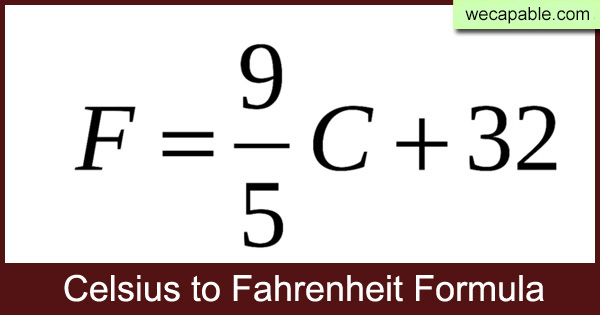Have you ever traveled to a new country and struggled to understand the local weather forecast? You might have seen a temperature displayed in Celsius, and wondered, “Is that hot or cold?” Or maybe you’re baking a cake, following a recipe that uses Fahrenheit, and you’re unsure how much the oven needs to be heated. These everyday situations highlight the importance of understanding temperature scales and how to convert between them. In this article, we’ll delve into the world of temperature conversion, focusing specifically on the conversion from Celsius to Fahrenheit.

Image: badegreedraza.blogspot.com
Temperature is a fundamental concept in science and daily life, measuring the degree of heat or cold of an object or substance. The Celsius and Fahrenheit scales are two commonly used systems, each with its own history and applications. By understanding how to convert between these scales, you can navigate the world of temperature with confidence and become a savvy consumer of weather forecasts, cooking instructions, and scientific data.
Understanding the Scales: Celsius and Fahrenheit
The Celsius scale, officially known as the Centigrade scale, is a metric system of measuring temperature. It’s named after Swedish astronomer Anders Celsius, who developed the scale in the 18th century. Celsius uses the freezing point of water as its zero point (0°C) and the boiling point of water as its hundredth degree (100°C).
Fahrenheit, on the other hand, is a system of measuring temperature named after German physicist Daniel Gabriel Fahrenheit, who proposed the scale in the early 18th century. The Fahrenheit scale uses the freezing point of water as 32°F and the boiling point of water as 212°F.
The Conversion Formula: Celsius to Fahrenheit
To convert a temperature from Celsius to Fahrenheit, we use the following formula:
°F = (°C × 9/5) + 32
Let’s break down this formula step-by-step:
- Multiply by 9/5: This step accounts for the difference in degree size between the Celsius and Fahrenheit scales. The Fahrenheit scale has smaller degree increments compared to the Celsius scale.
- Add 32: This step shifts the starting point of the Fahrenheit scale to 32°F, which corresponds to the freezing point of water on the Celsius scale (0°C).
Real-World Applications: From Cooking to Weather
Understanding how to convert between Celsius and Fahrenheit is essential in various aspects of life, from everyday activities to scientific research.
Cooking: Recipes often specify oven temperatures in Fahrenheit, while your oven might operate using Celsius. Converting between the scales ensures you bake your meals perfectly.
Weather: When traveling or checking a global weather forecast, the temperature might be displayed in Celsius. Knowing how to convert it to Fahrenheit helps you understand whether you need to pack a warm jacket or sunscreen.
Scientific Research: Researchers use temperature measurements for experiments and data analysis. Converting between Celsius and Fahrenheit ensures consistent scientific communication and accurate interpretations.

Image: sherlmacallen.blogspot.com
Beyond the Formula: Insights from Experts
Converting temperatures is a fundamental skill, but it can be more than just plugging numbers into a formula. To gain a deeper understanding of temperature scales and their applications, consider the following insights from experts:
- Temperature and Human Comfort: Dr. Emily Carter, a renowned climatologist, explains that understanding temperature scales is crucial for human comfort. “Knowing how temperature affects our bodies and our environment helps us adapt to different climates and make informed decisions about clothing, shelter, and outdoor activities,” she emphasizes.
- Temperature and Climate Change: Dr. Mark Jenkins, an environmental scientist, highlights the importance of temperature measurements in monitoring climate change. “Accurate temperature records help scientists understand the impact of global warming and track changes in weather patterns,” he notes.
Tips for Mastering Temperature Conversion
Here are practical tips to help you master Celsius to Fahrenheit conversions:
- Practice: The more you practice converting temperatures, the more familiar you become with the process. Start by converting familiar temperature values, such as the freezing and boiling points of water.
- Use Online Converters: Numerous online tools can convert temperatures between Celsius and Fahrenheit. These tools can be helpful for quick conversions, especially when you’re traveling or dealing with complex calculations.
- Learn the Relationship: Instead of relying solely on the formula, remember that 0°C corresponds to 32°F. This knowledge can help you make quick estimates and improve your understanding of the two scales.
4degrees Celsius To Fahrenheit
In Conclusion: A World of Temperature
Learning how to convert temperatures between Celsius and Fahrenheit empowers you to navigate the world with a deeper understanding of heat and cold. From reading weather reports to cooking delicious meals, this simple skill adds to your knowledge base and helps you make informed decisions in your daily life. Embrace the opportunity to explore the fascinating world of temperature conversions and unlock its potential to enhance your understanding of our physical environment.





